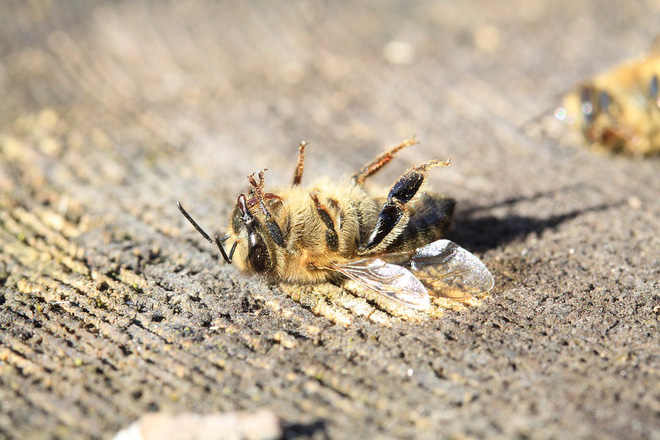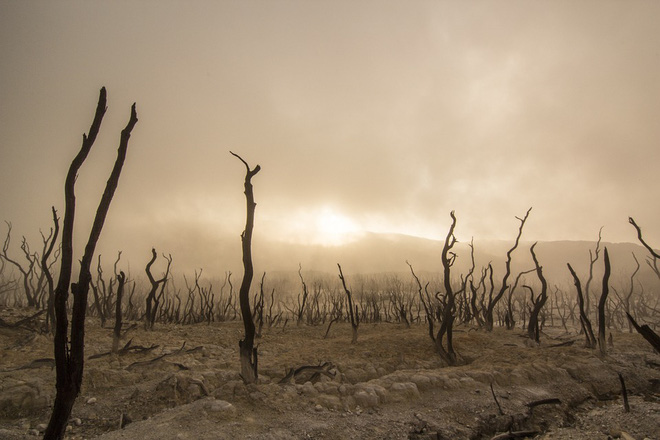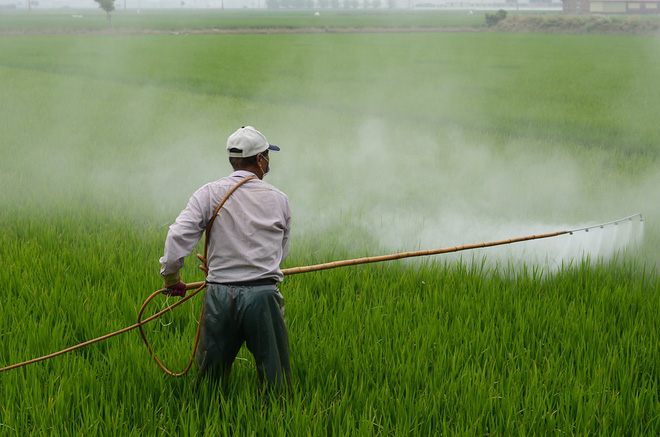Climate change puts bees at risk of extinction, but it's not too late for humanity to save them and save themselves
Surely when you were a child, you had encountered big bees and tried to avoid them from getting stung, or when you were walking in the backyard when you heard their buzzing around the blooming flowers.
If you don't encounter these situations today, it's because the effects of climate change have reduced the chances of meeting a bee bee by more than 30% on average since the 20th century. The scientific report was published on February 6 in the journal Science.
Scientists from the University of Ottawa in Canada analyzed the change in numbers of more than 66 species of bees on two continents in North America and Europe and compared data with climate change in those regions.
Their findings highlight that climate change causes excessive rainfall and temperature that turmeric bees can tolerate, leading to an increase in their extinction risk.

"The things that are attached to our childhood are disappearing very quickly," said Dr. Jeremy Kerr. He is the author of the report and a biology professor at the University of Ottawa.
"It is not simply that we are looking at the forthcoming experience of our children and grandchildren; we are looking back to a time less than a generation - when we were young - and saying 'can we take Do descendants go to places we once loved and discover what we once found? ' Our research says the answer is no on two continents . "
The number of bees is declining every decade
The scientists assessed the variability of the existence and abundance of turmeric bees in North America and Europe based on a database containing 550,000 records.
They estimated the distribution of bees spread across two continents over two periods: first from 1901 to 1974, second from 2000 to 2015. They then looked at the average monthly temperature and precipitation. in that area is beyond the tolerance of bees or not.
Turmeric likes a cool, humid climate and changes over seasons. A decrease in the number of turmeric bees is associated with a high frequency of temperatures and an increased wilting environment. This increases the risk of extinction for bees and eliminates their chances of migrating to new areas to create more species.
Scientists found a rapid and widespread decline in the number of turmeric bees across the two continents. In the studied areas, the chance of a bees existing in 2000 to 2015 decreased 46% in North America and 17% in Europe when compared with the old period.
"The term 'resident' refers to an animal migrating to a new area where there has never been an individual of that animal and establishing a new population , " Kerr said. "If that happens often, then it is likely that the species will be fine."
"The number of local extinctions we find is eight times that of resident events. Climate change is making these species disappear to a level where they cannot reproduce in time."

During the time that scientists analyzed, the climate across the United States and Europe was severely changing because of human activities. Over the past few hundred years, we have warmed the Earth to 1.3 degrees Celsius - close to the dangerous warming boundary of 1.5 degrees Celsius.
This is the reason for the decline to be stronger and more popular than previously reported, the authors say.
The loss in the number of turmeric bees can contribute to reducing biodiversity and depleting ecosystem services, affecting food and drinking water, climate control and disease, At the same time, the processes support nutrition and oxygen production. Besides, turmeric bees pollinate crops like cucumbers, tomatoes, squash, blueberries and watermelons.
"Turmeric bees are one of the best pollinators in the wild," said Peter Soroye, co-author of the report and PhD candidate at the University of Ottawa. " [They] are outside for a very long time of year, subject to a variety of different climatic conditions and land on a variety of flowers. They are truly an important part of the natural landscape that we have. still love . "
"Trees and crops based on turmeric pollen will suffer losses if the number of bees continues to decline or disappear completely, eventually leading to serious consequences for the ecosystem , " Haley Todd said. expression. She is the director of planning and education at Planet Bee, a non-profit organization based in San Francisco whose mission is to preserve bees. Todd was not part of the study.
Helping bees survive climate change
Other factors that affect the number of bees are the overuse of pesticides and changes in land use, which make the habitat of turmeric bees gradually lost.

In the report, the impact of climate change on bees is analyzed without taking into account human influence. That is, if we take that factor into account, the danger of extinction of bees will be even greater.
"The interaction between these factors is expected to accelerate the biodiversity decline of turmeric and many other species on a large scale," the report said.
However, there are still "many unique and unique conservation actions that can combat these genocide causes," Soroye said.
These include reducing pesticide use, planting various flowers and shrubs to prevent habitat from disappearing and providing shelter from the sun in "extreme weather events that bees have to deal with." face more often because of climate change , " Soroye said.
Beekeepers can protect the bees from intense sunlight and rain by planting shrubs instead of flowers, building covered hives and covering them with protective materials like wood.
The authors of the report suspect that their findings could apply to other species also facing extinction such as butterflies or birds.
"There are things we can do and recover that is possible." Kerr spoke. "We are not saying that all people need to do is immediately move to a forest tent to improve the situation. It points to a hopeful direction if we decide to intervene. cards " .
According to CNN
You should read it
- The surprising relationship between climate change - birth rate and consequences
- Global warming is killing intestinal bacteria in lizards
- Climate change is causing the sea to flow faster, scientists are still confused about what the harm will be
- Look for evidence of climate change in Antarctica with an iPhone
- Climate change will make you lose your Internet connection in the near future
- Birds are adapting to climate change because of their genes
- Successful production of Eco-Eco rice reduces climate change
- European scientists predict half of the current beach will disappear by the end of this century
May be interested
- 5 mass extinctions that shaped the Earth and the 6th is happening now
 the dinosaur extinction was just one of five global events that wiped out millions of species. how did these events happen? and how can we prevent them from happening again?
the dinosaur extinction was just one of five global events that wiped out millions of species. how did these events happen? and how can we prevent them from happening again? - Science warns: 70-90% of corals will disappear in the next 20 years, and become extinct in 80 years
 according to a new scientific report, climate change will destroy most of the coral reefs on earth by 2100.
according to a new scientific report, climate change will destroy most of the coral reefs on earth by 2100. - Look for evidence of climate change in Antarctica with an iPhone
 the photos are simple but a reminder of the consequences of climate change.
the photos are simple but a reminder of the consequences of climate change. - Do you know how 'honey' bees are?
 previously, scientists were curious about how bees clean the pollen on their bodies. and recently, they have the answer to this question.
previously, scientists were curious about how bees clean the pollen on their bodies. and recently, they have the answer to this question. - Fighting for partners can help animals adapt better when their living environment becomes harsh
 millions of organisms all over the planet are day by day, every hour fighting with negative effects caused by human-induced climate change.
millions of organisms all over the planet are day by day, every hour fighting with negative effects caused by human-induced climate change. - Function puts () in C
 the function int puts (const char * str) in the standard c library writes a str string to stdout (not writing null characters). a newline character (new line) is appended to the output.
the function int puts (const char * str) in the standard c library writes a str string to stdout (not writing null characters). a newline character (new line) is appended to the output. - Climate change will make you lose your Internet connection in the near future
 internet connectivity is being threatened by climate change and rising sea levels.
internet connectivity is being threatened by climate change and rising sea levels. - Birds are adapting to climate change because of their genes
 using genetics, ucla biologists participating in the genoscape project are racing against time to find the ability to adapt and the best way to protect vulnerable bird groups.
using genetics, ucla biologists participating in the genoscape project are racing against time to find the ability to adapt and the best way to protect vulnerable bird groups. - 30 hornets massacred 30,000 bees in 3 hours
 the video filmed by national geographic recorded the process of a swarm of 30 hornets attacking and killing 30,000 european honey bees, breaking into the nest and pulling out young bees to eat.
the video filmed by national geographic recorded the process of a swarm of 30 hornets attacking and killing 30,000 european honey bees, breaking into the nest and pulling out young bees to eat. - AI- Solution to combat global climate change
 in the context of global temperatures continuously reaching new record levels causing negative impacts, artificial intelligence (ai) is considered one of the potential solutions that can assist people in creating changes. positive change in the fight against climate change.
in the context of global temperatures continuously reaching new record levels causing negative impacts, artificial intelligence (ai) is considered one of the potential solutions that can assist people in creating changes. positive change in the fight against climate change.










 66 million-year-old dinosaur fossils contain a rare disease in modern-day children
66 million-year-old dinosaur fossils contain a rare disease in modern-day children A galaxy 500 million light-years away that emits radio waves with a 16-day cycle 'almost like squeezing lemons'
A galaxy 500 million light-years away that emits radio waves with a 16-day cycle 'almost like squeezing lemons' About 6 billion years from now, the light from the dying Sun will burn the asteroid belt
About 6 billion years from now, the light from the dying Sun will burn the asteroid belt Bill Gates: Artificial intelligence and gene editing technology will save humanity
Bill Gates: Artificial intelligence and gene editing technology will save humanity Breakthrough: The first discovery of an oxygen molecule outside the Milky Way
Breakthrough: The first discovery of an oxygen molecule outside the Milky Way In the future, scientists will use crystals to encode information
In the future, scientists will use crystals to encode information